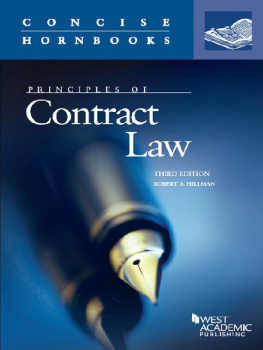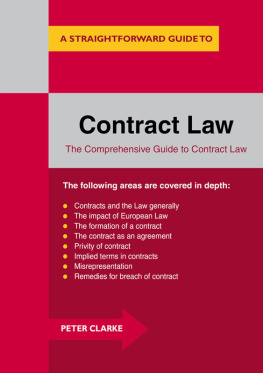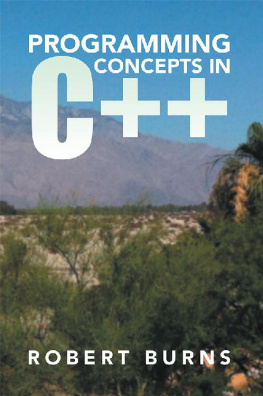WESTS LAW SCHOOL
ADVISORY BOARD
___________
JESSE H. CHOPER
Professor of Law and Dean Emeritus,
University of California, Berkeley
JOSHUA DRESSLER
Professor of Law, Michael E. Moritz College of Law,
The Ohio State University
YALE KAMISAR
Professor of Law Emeritus, University of San Diego
Professor of Law Emeritus, University of Michigan
MARY KAY KANE
Professor of Law, Chancellor and Dean Emeritus,
University of California,
Hastings College of the Law
LARRY D. KRAMER
President, William and Flora Hewlett Foundation
JONATHAN R. MACEY
Professor of Law, Yale Law School
ARTHUR R. MILLER
University Professor, New York University
Formerly Bruce Bromley Professor of Law, Harvard University
GRANT S. NELSON
Professor of Law, Pepperdine University
Professor of Law Emeritus, University of California, Los Angeles
A. BENJAMIN SPENCER
Professor of Law,
Washington & Lee University School of Law
JAMES J. WHITE
Professor of Law, University of Michigan
I
PRINCIPLES OF CONTRACT LAW
Third Edition
by
Robert A. Hillman
Edwin H. Woodruff Professor of Law
Cornell Law School
CONCISE HORNBOOK SERIES

Mat #41484468
II
The publisher is not engaged in rendering legal or other professional advice, and this publication is not a substitute for the advice of an attorney. If you require legal or other expert advice, you should seek the services of a competent attorney or other professional.
Concise Hornbook Series and Westlaw are trademarks registered in the U.S. Patent and Trademark Office.
West, a Thomson business, 2004
2009 Thomson Reuters
2014 LEG, Inc. d/b/a West Academic
444 Cedar Street, Suite 700
St. Paul, MN 55101
1-877-888-1330
West, West Academic Publishing, and West Academic are trademarks of West Publishing Corporation, used under license.
Printed in the United States of America
ISBN: 9780314288943
III
For the members of the Bob Hillman and His Assorted Followers Club with much love and appreciation
V
Preface to the Third Edition
___________
The prefaces to the first and second editions (on the following pages) set forth my goals, organization, and the scope of this book. In this third edition, I have added new discussions of accord and satisfaction and arbitration and have supplemented the material on, among other things, duty to disclose, fault in contract law, liquidated damages, restitution, and unconscionability. I have also added cases to the footnotes throughout the book that have arisen since the publication of the second edition. These cases illustrate how the core concepts and principles of contract law discussed in the text remain crucial today. As with the second edition, I have tried to catch typos and have clarified some obtuse language to make this third edition as clear as possible.
Many thanks to my research assistants Phil Mercadante, Michael Milazzo, Damien Rose, and Kirk Sigmon for their excellent contributions to this third edition.
Worth repeating is my confidence that you will enjoy your contracts course and, hopefully, this book. (To determine whether I have just made an express warranty, please see Chapter 3, Part C of this book.)
Robert A. Hillman
Ithaca, New York
August 2013
VII
Preface to the Second Edition
___________
My goals, organization, and the scope of this book remain the same as in the first edition. In fact, lots of text remains intact. So carefully peruse the Preface to the first edition if you want to know what this book is all about.
Why write a second edition, you probably are wondering, in light of the first paragraph above. Well, for one thing, I have edited and revised several sections of the book, mainly to keep up with how changes in technology have influenced contract law. For another, I have supplemented the footnotes with recent cases, including quotations from the cases (as in the first edition). I added cases, not so you will get bogged down reading the footnotes (there are still only a few textual footnotes), but to help you capture how recent decisions treat the core concepts discussed in text and to aid you in your research of recent contract law. Finally, I have caught the typos and cleaned up some obtuse language (I hope) that students using the first edition have enjoyed telling me about.
Many thanks to Daniel Forester, Juan Soto, and Mireille Zuckerman for their excellent research work on this second edition.
I am confident that you will enjoy your contracts course. Hopefully, you will enjoy this book. Good luck!
Robert A. Hillman
Ithaca, New York
August 2009
IX
Preface to the First Edition
___________
I have written this book to help students understand and apply the greatest of law subjects, namely contract law. But it is not a substitute for hard work. I strongly recommend that you read and study the cases in your casebook, take feverish notes in class, and synthesize the material in your own outline of the course. You should use this book to review concepts, to clarify issues that give you trouble even after all your diligent work, and to help you understand how everything fits together. The book should also prepare you well for contracts questions on the bar exam (so keep it in good shape).
To get a feel for the nature and scope of this book, please take a look at Chapter 1, which is an introduction. Here I simply want to list some of the books attributes that will facilitate your understanding of contract law:
1. I have tried to explain concepts clearly and concisely. The writing is informal, and I even have attempted to be humorous at times (you, of course, will be the judge of whether I succeeded).
2. The book contains numerous examples and illustrations of rules and principles. Often, I have taken the liberty of assigning you a role in a problem, on the theory that you will be most interested and attentive if you can envision having something at stake. (For example, Chapter 1 asks whether you have any legal rights to a 2001 Ferrari after you see an advertisement in the newspaper listing the car for sale for $30,000 and you call the owner and say you want to buy the car.)
3. For ease of reading and understanding, the book omits annoying textual footnotes that often confuse the reader or make issues more difficult and complex than necessary. Instead, the footnotes cite cases, articles, and treatises, with most including short quotations to substantiate positions taken in the text. But for a straightforward explanation of rules and principles, you dont have to look at the footnotes at all.
4. The book contains lots of cross references in case you want to review concepts that are building blocks for the current material you are reading.
X
5. The book covers all of the major issues of contract law and discusses in text most of the leading contracts cases that appear widely in the various contracts casebooks.
6. The book covers timely issues such as amended Article 2 of the Uniform Commercial Code and electronic contracting.
Many people helped me in this endeavor. Thanks to April Anderson, Phil Cummins, Imri Eisner, Eric Franklin, Courtney Herz, Heather Hillman, Jessica Hillman, Emily Paavola, Brad Wilson, and Nathaniel Yale for excellent research assistance, extensive work on the footnotes, and editorial suggestions. Thanks also to Professor James Henderson for reading early chapters, and Karen Wilson for her general assistance. As always, Betsy Hillman supplied encouragement and support.














